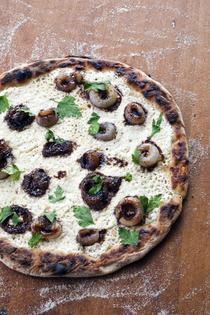Mario Batali: Balsamic, Onion and Goat Cheese Pizza
When the leaves start turning and the nights become longer, I know my little onions are back and ready for some good cooking. I could not be happier. Cipolline are small, flat and pale onions, with mild flesh and papery thin skins. Ranging from pale yellow to light brown, their color resembles that of Spanish onions. Cipolline are sweeter, however, containing less residual sugar than shallots but more than garden-variety white or yellow onions. Specialty markets and grocery stores have them in stock when harvested in autumn, but prices become less reasonable when these flavor-packed babies are not in season.
A benefit of cipolline for home cooks is that their shape lends them well to roasting. My Balsamic-Glazed Cipolline combines the tenderness of these onions with a syrupy vinegar glaze for a result that practically melts in your mouth. This makes for a unique substitution where you might otherwise want to use whole caramelized onions. Their seasonal flavor makes cipolline perfect for recipes like Otto Pizzeria e Enoteca's classic fall favorite: Balsamic, Onion and Goat Cheese Pizza.
The base of my pizza, an easy and versatile dough, is one that I've used for the restaurants as well as at home for years. I use the same recipe for flatbreads, both savory and sweet, and the recipe can be found in "Molto Gusto" or on mariobatali.com. I recommend making only one pizza at a time and serving each one as soon as it's done. If you need to make a lot for a large party, cook several of them once (slightly undercook them) and then reheat them in a warm oven before serving.
Balsamic, Onion and Goat Cheese Pizza
Excerpted from "Molto Gusto" by Mario Batali (ecco, 2010)
Makes 6 slices.
1 parbaked pizza crust
2 ounces creamy young goat cheese, such as Coach Farm, at room temperature
8 Balsamic-Glazed Cipolline (recipe follows)
Fresh Italian parsley leaves, for garnish
1 tablespoon extra virgin olive oil
Spread the goat cheese evenly on the pizza crust, leaving a 1/2 inch border. Halve the onions horizontally and arrange on the goat cheese. Slide the pizza under the broiler, about 4 inches from the heat source, and broil for 7 or 8 minutes, until the topping ingredients are heated and/or cooked through and crust is charred and blistered in spots. Watch closely so that the ingredients don't burn; move the pizza around or lower the broiler-rack if necessary. If you prefer more color, move the pizza closer to the heat source at the very end before removing. Sprinkle the parsley over the pizza and drizzle with the olive oil. Cut into 6 slices and serve.
Balsamic-glazed Cipolline
Makes a generous 1 cup
1 tablespoon extra virgin olive oil
1/2 tablespoon unsalted butter
8 ounces small cipolline, peeled
1/4 cup balsamic vinegar
1/4 cup water
1 1/2 teaspoons sugar
Combine the oil and butter in a large saute pan and heat over the medium-high heat until the foam subsides. Add the onions and cook, turning once or twice, until well browned on both sides, 7 to 9 minutes. Add vinegar, water and sugar, stirring to dissolve the sugar, and then reduce the heat and boil gently, turning the onions occasionally, until they are tender and the liquid has reduced to a syrupy glaze, about 12 minutes. Remove from the heat and let cool. (The onions can be refrigerated for up to 3 days; bring to a room temperature before using.)
(Mario Batali is the award-winning chef behind 24 restaurants including Eataly, DelPosto, and his flagship Greenwich Village enoteca, Babbo.)







